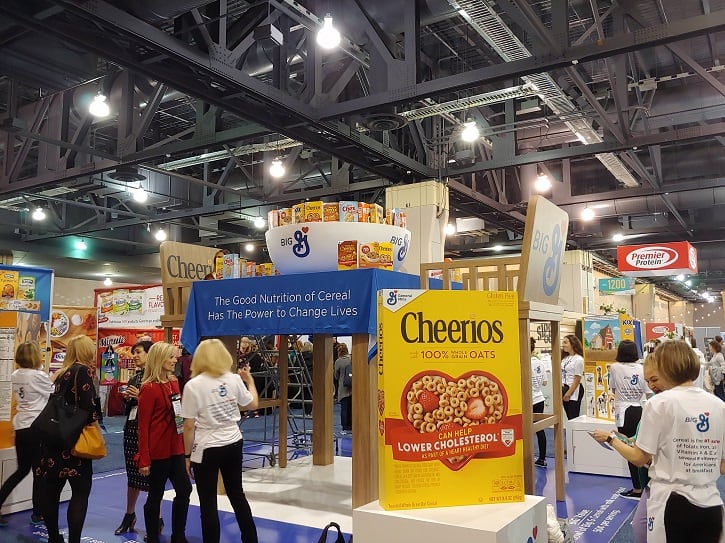While the impact of COVID-19 is not reflected in the results of General Mills' third quarter, which ended Feb. 23 and were reported March 18, the pandemic has fueled “increased customer orders and higher retail sales takeaway in Nielsen-measured channels since the beginning of March” when the virus’ impact began hitting the US, company chairman and CEO Jeff Harmening told analysts during the company's third-quarter earnings call March 18.
“Our US retail sales results for the week ended March 7 were up low double-digits, including pet, and we anticipate takeaway for the week ending March 14 will be many times higher across all channels,” he said, adding he expects “overall at-home food demand will remain elevated in Q4,” with the bulk of an “unwind” not happening until fiscal 2021.
In response to the heightened demand, Harmening said, General Mills is focused on maintaining its supply chain, which he said is “operating effectively around the world” and so far has allowed the company to service the vast majority of customer demand to date.
While he acknowledged this could change if the virus situation material worsens, Harmening assured investors on a company call March 18 that “up until this point, the supply chain has been working remarkably well and our service levels are well over 90% … despite the pictures of store shelves being empty.”
He explained that General Mils has “a control tower in place across North America” that is balancing all of the company’s North American businesses across retail, convenience, foodservice and pet. “That control tower is a live group of people and systems that are working 24/7 and really balancing where we are seeing demand, what lines are running and what products are running.”
As suggested by FMI earlier this week, Harmening confirmed that General Mills, like others, is working closely with retailers to identify ways to “simply the supply chain.”
He explained, “in some cases, that might mean running fewer SKUs or running the big SKUs of soup and not running some of the tail brands.”
With regards to shipping, he added, General Mills is discussing with retailers shipping full pallet quantities as opposed to mix layers of pallets and making trade-offs around direct store deliveries, which he said is “actually a very good thing.”
Given the rapidly changing situation, Harmening added, General Mills is talking with many retailers hourly to adjust plans to best serve them in the short and long-term.
Employee safety key to success in face of COVID-19
In order to maintain the fast pace of production required of the current situation, Harmening said that General Mills is focused on the safety of its employees and cleanliness of its facilities.
For example, he noted, General Mills already follows “very strict food safety guidelines and employee safety guidelines at our plants, hand-washing and things like that, and the guidelines set forth by the FDA and USDA.”
In addition, the company has adjusted its leave policy to ensure that people who are paid to stay home, and for those at work the company has, in comes cases, encouraged social distancing by staggering breaks.
Harmening also reiterated FDA’s message from earlier in the week that there is currently o evidence of food or food packaging being associated with transmission of COVID-19, which means the company can continue production through the course of normal actions.
Adjustments to marketing and promotions
With product flying off the shelf faster than some retailers can restock, Harmening said, General Mills is working with its partners to determine appropriate promotional activities that can raise brand awareness without negatively contributing to excessive purchases by some that are restricting access to others.
While Harmening said most conversations with retailers are around servicing the day-to-day right now, he said some are starting to talk about promotional calendars in the short- and long-term.
“At some of our retail customers, we have pulled back merchandising in April jointly and others were just beginning that conversation,” he said.
The advertising side, is a slightly different matter.
Harmening said General Mills is striving to strike the right tone when talking about its brands on social media, TV and other outlets, given the ongoing pandemic. For example, that includes not talking about stocking out.
“Having said that,” he added, “brand building is a long-term investment. It’s not only what we do this quarter. So we will continue to build our brands in appropriate ways, because the impact is not only for now, but it’s three months from now and six months from now.”
Based on his “opinion with very little data to back it up,” he added, brand-building advertising “also can [instill] a sense of normalcy for people as their lives are anything but normal on many parts of the world. And so, for us, we think we have a responsibility to do that – whether it’s delivering our product or whether it’s advertising Cinnamon Toast Crunch.”
Beyond COVID-19
Reminding investors that COVID-19 had not yet hit the US when General Mills closed its third quarter, the company noted no major bump in sales during the period.
Rather, net sales of $4.2 billion were flat compared to the same time last year, as were organic net sales other than in the pet segment. Net earnings, however, were up slightly by 2% to $454 million for the quarter.
This resulted in a diluted earnings per share of 74 cents, which matched prior-year results and adjusted EPS of 77 cents, which was down 6% from the prior year.
Factoring in the potential impact of COVID-19 on the rest of the fiscal year, General Mills altered its guidance to reflect an adjusted operating profit up 4-6%, which is ahead of the previous range of 2-4% growth. Adjusted diluted EPS are now expected to increase 6-8% from the base of $3.22 earned in fiscal 2019, which is up from the prior range of 3-5%.




